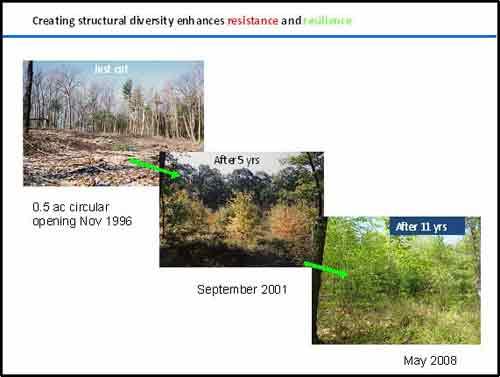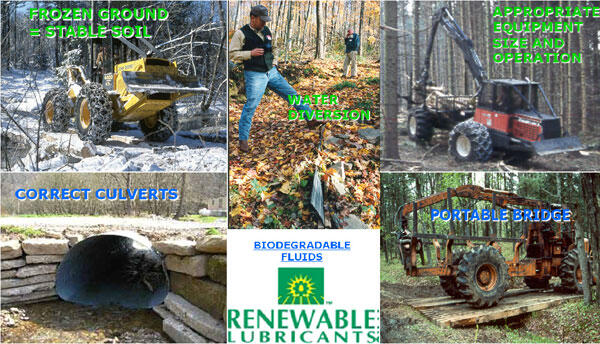Overview
The Division of Water Supply Protection (DWSP) is determined to protect our water resources for future generations. Forest cover provides unparalleled water quality. DWSP has determined that the most stable land cover comes from a vigorous, species-diverse, many-aged forest. The Division’s long term objective is to diversify today’s mostly even-aged forest into a multi-aged forest. We are determined to do this while conserving biodiversity using sustainable forestry practices. This process will not be fully implemented for many decades because we are proceeding at a measured pace.
DWSP Foresters design timber harvests that will regenerate about 1% of the managed forest every year so that gradually, over time, the managed forest will include a much broader range of age classes than is currently present. Simultaneously, large unmanaged stands of trees are left to grow to biological maturities ranging from 100 to 400 or more years of age.
The overall purpose of this management is to restore the forest to more balanced proportions of young, mid-aged, and older trees comprised of the greatest possible variety of native species. DWSP's working hypothesis is that the new makeup of the forest will help ease the damage caused by inevitable future severe weather events, outbreaks of disease, and insect infestations.
Video: DCR Watershed Forestry: Managing for Resistance and Resilience
Skip this video DCR Watershed Forestry: Managing for Resistance and Resilience.The Forest Biofilter
What’s the best way to protect drinking water?
Forested watersheds provide a living green bio-filter that functions 24 hours a day on free solar energy and is as reliable and efficient as the most responsibly engineered water treatment plant. It catches the rain, stores it, and releases it slowly, soaking up nutrients, keeping erosion to a minimum, and yielding a consistent supply of clean water.
But, as good as these forests are at protecting and providing drinking water, they are vulnerable to a wide array of natural and human caused disturbances.
Natural Disasters
Diversity is a good thing when it comes to the ability of the forest to resist damage or rebound quickly in the wake of a hurricane or major insect infestation. However, right now our watershed forests are not as diverse in age or structure as they could be.
Because of decades of over-browsing by deer, previous land use patterns, and the legacy of the 1938 hurricane, only 10% of the forest is less than 15 years old, and the rest is mostly even aged, and 70 or more years old. Why are age and height important? A study of damage to the forest from the 1938 hurricane found a general trend of increasing damage with age. Depending on the species, 10 year-old stands were damaged at the rate of 0 to 15%, whereas 30 year-old stands were damaged at rates ranging from near zero to 100%. At age 70, the minimum damage rate was 30%.
That is why DWSP forest managers are following a publicly reviewed management plan that will gradually lead to a well balanced mix of young, mid-aged, and older trees (as well as a variety of species) well distributed across the watershed.
Building Resistance and Resilience
The Role of the Forest Management
How can active forest management increase the structural and age-class diversity of the forest?
New seedling and stump sprout growth requires the presence of sunlight on the forest floor, usually from a newly created opening in the canopy. The forest management plan calls for creating openings ranging in size from a single tree up to an acre or two and totaling less than 1% of the forest area per year. This strategy mimics the average rate of natural disturbance, but in a deliberate pattern spread over time and space that differs from nature’s random, often spatially concentrated events. By 2055, the outcome will be a diverse, actively reproducing, multi-layered watershed protection forest that is more resistant and resilient than what we have today.
Protecting Water Quality
DWSP uses well tested methods on watershed lands to avoid or minimize the risks to water quality associated with active management, and monitors the outcomes. Measures include:
- protective buffers adjacent to streams and wetlands
- seasonal restrictions on logging activities
- portable bridges for stream crossings
- equipment restrictions
- locating log landings away from water resources
- other Conservation Management Practices
More than 1,000 timber harvests have been conducted over the last 50 years on DWSP lands, and our monitoring has shown no decreases in water quality related to these harvests. The DWSP water supply remains among the cleanest and purest in the world.
Conserving Biodiversity
How does biodiversity conservation factor into management of the watershed forest?
Over 100,000 acres of DCR watershed forests are protected from development and will remain in a forested condition. Perpetual forest cover over such a large area contributes significantly to the long-term health and survival of a variety of organisms and natural communities.
In addition, dozens of rare, unique or exemplary plant communities and rare animals have been identified, mapped, and are being monitored to ensure their long-term survival. Over 17,000 forested acres across the DWSP watershed system receive limited management and may be developing growth characteristics where they have escaped catastrophic natural disturbances for a century of more. DWSP has worked closely with Natural Heritage and Endangered Species Program staff to develop Wildlife Conservation Management Practices for the protection of habitats and rare species during land management operations.

